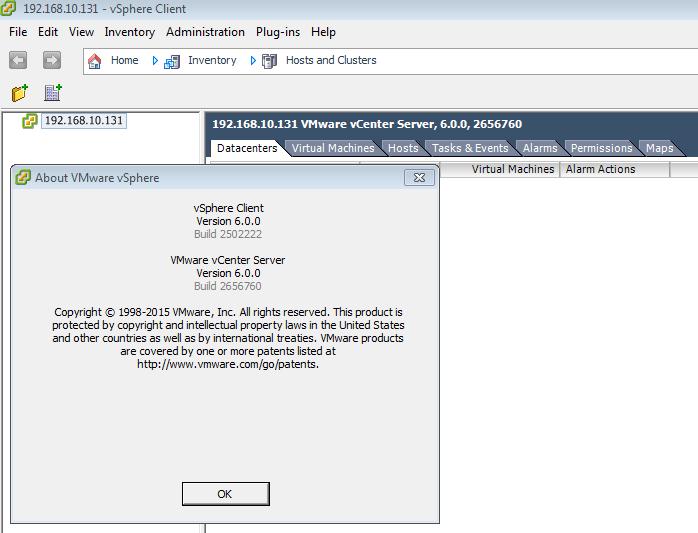HOW TO: Install and Configure VMware vSphere Update Manager (VUM) 6.0
EE Fellow, MVE, Expert of the Year 2021,2017-11, Scribe 2016-2012, Author of the Year 2018-6,2013-2012 VMware vExpert Pro, vExpert 2022-2011
Published:
Browse All Articles > HOW TO: Install and Configure VMware vSphere Update Manager (VUM) 6.0
In this tutorial article, I will show you how to install and configure the VMware vSphere Update Manager 6.0. VMware vSphere Update Manager 6.0 is a component which can be found on the vCenter Server 6.0 DVD ISO. VMware vSphere vCenter Server for Windows is available as a 60 day evaluation, found here.
Here, we will use Microsoft Windows Server 2012 as the operating system of choice to support the VMware VMware vSphere Update Manager 6.0. I also recommend the use of a virtual server to support vCenter Server for Windows.
I have written the following EE article on how to install this operating system for your convenience:
Follow the steps below to install and configure the VMware vSphere Update Manager 6.0:
1. Installing VMware vSphere Update Manager 6.0
![VMware-vSphere-Update-Manager-6.0-instal]()
![VMware-vSphere-Update-Manager-6.0-instal]()
![VMware-vSphere-Update-Manager-6.0-instal]()
![VMware-vSphere-Update-Manager-6.0-instal]()
![VMware-vSphere-Update-Manager-6.0-instal]()
![VMware-vSphere-Update-Manager-6.0-instal]()
![VMware-vSphere-Update-Manager-6.0-instal]()
![VMware-vSphere-Update-Manager-6.0-instal]()
![VMware-vSphere-Update-Manager-6.0-instal]()
![VMware-vSphere-Update-Manager-6.0-instal]()
![VMware-vSphere-Update-Manager-6.0-instal]()
![VMware-vSphere-Update-Manager-6.0-instal]()
![VMware-vSphere-Update-Manager-6.0-instal]()
![VMware-vSphere-Update-Manager-6.0-instal]()
![VMware-vSphere-Update-Manager-6.0-instal]()
![VMware-vSphere-Update-Manager-6.0-instal]()
![VMware-vSphere-Update-Manager-6.0-instal]()
![VMware-vSphere-Update-Manager-6.0-instal]()
![VMware-vSphere-Update-Manager-6.0-instal]()
![VMware-vSphere-Update-Manager-6.0-instal]()
![VMware-vSphere-Update-Manager-6.0-instal]()
![VMware-vSphere-Update-Manager-6.0-instal]()
2. Testing and Configuring VMware vSphere Update Manager 6.0.
![vc60.jpg]()
![192.168.10.131---vSphere-Client-000069.j]()
![192.168.10.131---vSphere-Client-000071.j]()
![192.168.10.131---vSphere-Client-000072.j]()
Congratulations you have successfully Installed and Configured VMware vSphere Update Manager 6.0.
Basic VMware Articles Series:
During this series of articles VMware released VMware vSphere 5.5 and VMware vSphere Hypervisor ESXi 5.5. These articles are also applicable to VMware vSphere Hypervisor ESXi 5.0 and 5.5. For consistency, I have used VMware vSphere Hypervisor ESXi 5.1 throughout this series.
************************************************************************************************
Thank you for reading my article, please leave valuable feedback. If you liked my VMware article and would like to see more Articles from me, please click the Yes button near the: Was this article helpful? at the bottom of this article just below and to the right of this information. Thank You. Do not forget if you have a question about this article or another VMware, Virtualisation, Windows Server 2012 question, why not post a Question for Me and the other Experts Exchange Experts in the VMware, Virtualisation, Windows 2008, Windows 2012 Zones. I look forward to hearing from you. - Andy :- twitter @einsteinagogo
************************************************************************************************
Here, we will use Microsoft Windows Server 2012 as the operating system of choice to support the VMware VMware vSphere Update Manager 6.0. I also recommend the use of a virtual server to support vCenter Server for Windows.
I have written the following EE article on how to install this operating system for your convenience:
Follow the steps below to install and configure the VMware vSphere Update Manager 6.0:
1. Installing VMware vSphere Update Manager 6.0
- After inserting the DVDROM or mounting the ISO image in the server, autorun will start.
- You will need at least 2 vCPU and 4GB RAM memory for the server and to make sure that Microsoft .NET 3.5 is installed.
- Give yourself at least 2 hours to complete the installation.
- Select vSphere Update Manager, then Server, and click Install. Ensure that the tick box is selected to use an Embedded Database of Microsoft SQL Server 2012 Express Edition, which is recommended for small installations.
- Microsoft SQL Server 2012 Express SP2 will be installed as part of the installation.
- Microsoft SQL Server 2012 Express Edition installation is completed, Click OK to install Update Manager.
- Click Next to continue.
- Select "I accept the terms in the license agreement", and click Next to continue.
- Select Next to continue.
- Enter the IP Address or the FQDN of your vCenter Server 6.0 server and an Administrator username and password. Here, I'm using the Administrator@vsphere.loca
l username and password. - Select Next to continue.
- Leave the ports as default and configure the proxy settings if required.
- Select Next to continue.
- Accept the default destination Folders.
- Select Next to continue.
- Click Install.
- Click Finish to complete the installation.
2. Testing and Configuring VMware vSphere Update Manager 6.0.
- Using the vSphere Client or a Web Browser, you can check and connect to your vCenter Server (use the Administrator@vsphere.loca
l account and password to login the first time). The address for your web browser is https://<IP Address>:/vsphere-client/. Please note that 9443 has gone!

- Click Plug-ins > Manage Plug-ins.
- Scroll down to Available Plug-ins. Download and Install the VMware vSphere Update Manager extension on your local Administratiron Workstation.
- Select Home > Inventory > Solutions and Applicatons > Update Manager.
Congratulations you have successfully Installed and Configured VMware vSphere Update Manager 6.0.
Basic VMware Articles Series:
During this series of articles VMware released VMware vSphere 5.5 and VMware vSphere Hypervisor ESXi 5.5. These articles are also applicable to VMware vSphere Hypervisor ESXi 5.0 and 5.5. For consistency, I have used VMware vSphere Hypervisor ESXi 5.1 throughout this series.
**************************
Thank you for reading my article, please leave valuable feedback. If you liked my VMware article and would like to see more Articles from me, please click the Yes button near the: Was this article helpful? at the bottom of this article just below and to the right of this information. Thank You. Do not forget if you have a question about this article or another VMware, Virtualisation, Windows Server 2012 question, why not post a Question for Me and the other Experts Exchange Experts in the VMware, Virtualisation, Windows 2008, Windows 2012 Zones. I look forward to hearing from you. - Andy :- twitter @einsteinagogo
**************************
Have a question about something in this article? You can receive help directly from the article author. Sign up for a free trial to get started.


Comments (0)